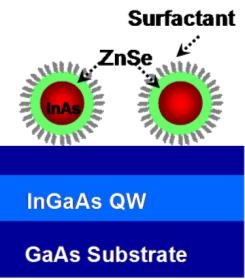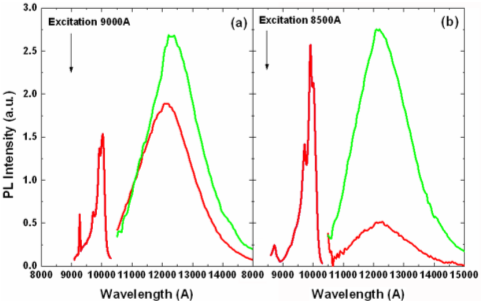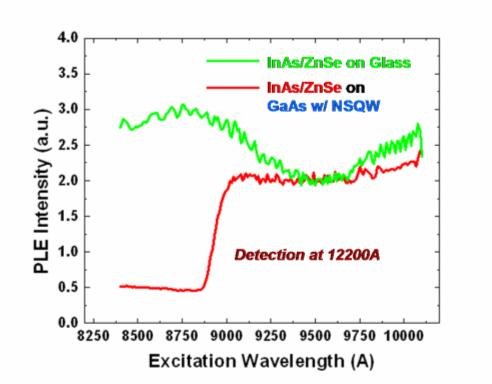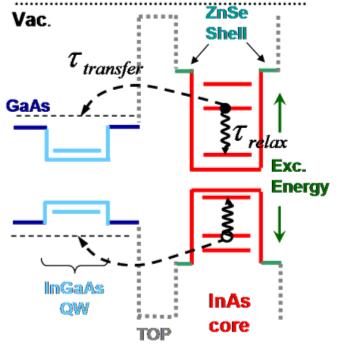|
|
|
|
Integrated
Epitaxical and Colloidal Nanostructure - Study of Energy
Transfer
|
| This
work is supported by: DURINT-01
AFOSR Grant No. F49620-01-1-0474
|
In
this study, the integrated colloidal and epitaxical
nanostructure is formed by adsorbing a sub-monolayer
of InAs/ZnSe core/shell nanocrystal on MBE prepared
GaAs substrate with a InGaAs near surface quantum
well (NCQD). Figure 4 shows the room temperature
PL of InAs/ZnSe NCQDs deposited on such near
surface QW (red) and on glass (green) substrates
with excitation at 900nm (panel a) and at 850nm
(panel b). At room temperature, the former is
below and the latter above the GaAs band gap
(872nm). The PL response from NCQDs on glass
(fig.2, green) for excitation at either wavelength
is essentially the same with a peak at 1220nm.
|

|
 |
|
|
Figure 1. Shows schematic of InAs/ZnSe core/shell nanocrystal
quantum dots with its surfactant in contact with GaAs
substrate with buried near surface InGaAs QW.
|
Figure 2. Room temperature PL of NCQDs on different
substrates for excitation at (a) below (9000nm) and
(b) above (8500) GaAs band gap. In both panels, on glass
(green); on NSQW containing GaAs (Red).
|
|
However,
for the NSQW containing GaAs substrates, the NCQD
PL peak intensity at 1220nm is seen to drop by a factor
of ~5 as the excitation goes from below to above GaAs
band gap. This drop in PL intensity is also manifested
in the corresponding PLE spectra (figure 3) for detection
at the peak of the NCQD PL. Note that the PLE of NCQDs
on glass shows only small variation in the excitation
wavelength region of 850nm-1000nm, manifesting the
near constancy of the absorption coefficient of the
NCQDs in this regime. By contrast, the PLE intensity
of the NCQDs on GaAs substrate with NSQW is seen to
exhibit step-like drop as the excitation energy changes
from below to above the GaAs band gap. The reduction
in PL intensity of the NCQDs on NSQW containing GaAs
substrate at excitation energies above the GaAs band
gap implies that the substrate is quenching the luminescence
of the adsorbed NCQDs due to energy transfer from
the NCQDs into the substrate. This may be understood
with the help of the energy band diagram (fig.4) for
InAs/ZnSe NCQD on NSQW containing GaAs substrate.
GaAs has a room temperature bandgap of 1.42eV (872nm),
larger than the ~1eV (1100nm) ground state transition
energy for our InAs/ZnSe NCQDs. Remember that excitation
(absorbtion) in the NCQDs is occurring in their higher
energy excited states (see fig.4). Once excited, relaxation
processes of the electron-hole pair (exciton) created
in NCQDs come into play. At low excitation power density,
following the creation of electron-hole pair in the
NCQDs, the eventual ground state luminescence from
the NCQDs may be approximated to be controlled by
a two-step process: excitons first relax thermally
into the ground state, and then recombine radiatively
to emit photons. If NCQDs are excited with a photon
energy lower than the GaAs bangap, no transfer to
the substrate can occur during the exciton thermal
relaxation to its ground state. By contrast, when
excited with a photon energy higher than the GaAs
bandgap, energy transfer into the substrate can occur
(if empty states of matching energy exist) that competes
with thermal relaxation to the NCQD ground state.
Indeed, the opening of the energy transfer pathway
thus lowers the ground state luminescence yield of
the NCQDs which is manifested as the step feature
in the NCQD PLE spectrum. This is the first experimental
demonstrate of such an energy transfer from the nanocrystal
quantum dots into the underlining semiconductor substrate.
|

|

|
|
| Figure 3. Room temperature PLE of NCQDs
deposited on: glass (broken curve), NSQW containing GaAs
(Red). Detection is at 1220nm (NCQD PL peak). |
Figure 4 Schematic energy level alignment
of the NC/substrate system depicted in figure 1. |
|
| |
Reference:
[1] S. Lu, A. Konkar and A. Madhukar, Nano Letter (submitted)
|
|
|
|
|